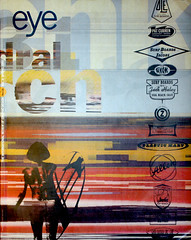Spring 1995
Design for the underground
Mr Beck's Underground Map
Ken Garland<br>Capital TransportFollowing his seminal 1969 article in the Penrose Annual, ‘The Design of the London Underground Diagram’, Ken Garland has now written and designed a full-length history of Henry C. Beck’s internationally renowned map.
Garland, a close friend until Beck’s death in 1974, was bequeathed his archive of early sketches and mock-ups, together with later revision material and the correspondence that followed his abrupt and acrimonious dismissal as designer of the diagram in 1960. Mr Beck’s Underground Map (Capital Transport, £9.95) uncovers early transport maps that employed some of the distinctive iconography and geographical distortion which were to prove so revolutionary in Beck’s uncompromising version. Beck’s geometric construction and disregard for surface features (except for the Thames) presented a simple but comprehensive transport system whose unifying corporate image was to be of great value to the newly formed London Passenger Transport Board.
Garland charts a fascinating evolution through the many editions produced during Beck’s 27 years of involvement as a designer of the diagram. Beck’s tireless work, displaying near obsession for best solutions, repeatedly demonstrated the diagram’s most salient feature: its ability to adapt, within its original terms, to an expanding Underground network.
The book itself reflects the typical directness of much of Garland’s design. Long captions allow fascinating side-trips into Beck’s design process and the production details of many editions. The writing is engaging, at times almost colloquial. Garland establishes the context of Beck’s professional life in the 1930s and explores the corporate machinations that were eventually to undermine his hold on the diagram.
Garland’s work is rarely without a message and one emerges here prominently. Beck’s intensity and goodwill led him to assume indefinite stewardship of his creation – an idea later dismissed by his London Transport bosses – and Garland finds this persistence essential to the very existence of the diagram and its longer term success. For in such a commitment, he argues, lies the greatest likelihood of a true design ‘classic’ evolving. The chance to imbue utility in context and refinement over time creates a resonance for the public and designers alike.
The history of graphic design has no shortage of classics. Discussion of the sort Garland offers is vital in establishing the criteria by which work has entered our canon of generally agreed good practice. In setting out his notion of what might be valuable to the field of graphic design, Garland has unequivocally reaffirmed Beck’s diagram as the profession’s own.
Eric Kindel, senior lecturer, Central Saint Martins, London
First published in Eye no. 16 vol. 4, 1995
Eye is the world’s most beautiful and collectable graphic design journal, published quarterly for professional designers, students and anyone interested in critical, informed writing about graphic design and visual culture. It is available from all good design bookshops and online at the Eye shop, where you can buy subscriptions and single issues.

